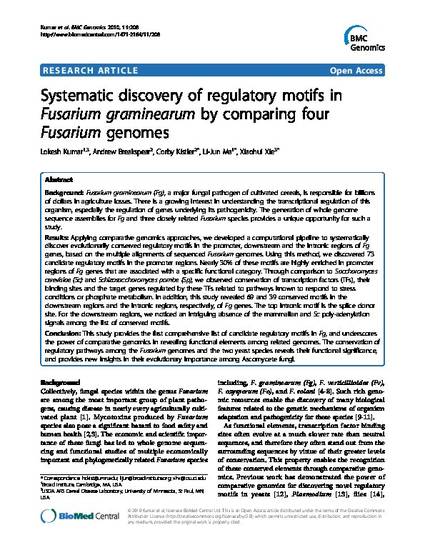
Background
Fusarium graminearum (Fg), a major fungal pathogen of cultivated cereals, is responsible for billions of dollars in agriculture losses. There is a growing interest in understanding the transcriptional regulation of this organism, especially the regulation of genes underlying its pathogenicity. The generation of whole genome sequence assemblies for Fg and three closely related Fusarium species provides a unique opportunity for such a study.
Results
Applying comparative genomics approaches, we developed a computational pipeline to systematically discover evolutionarily conserved regulatory motifs in the promoter, downstream and the intronic regions of Fg genes, based on the multiple alignments of sequenced Fusarium genomes. Using this method, we discovered 73 candidate regulatory motifs in the promoter regions. Nearly 30% of these motifs are highly enriched in promoter regions of Fg genes that are associated with a specific functional category. Through comparison to Saccharomyces cerevisiae (Sc) and Schizosaccharomyces pombe (Sp), we observed conservation of transcription factors (TFs), their binding sites and the target genes regulated by these TFs related to pathways known to respond to stress conditions or phosphate metabolism. In addition, this study revealed 69 and 39 conserved motifs in the downstream regions and the intronic regions, respectively, of Fg genes. The top intronic motif is the splice donor site. For the downstream regions, we noticed an intriguing absence of the mammalian and Sc poly-adenylation signals among the list of conserved motifs.
Conclusion
This study provides the first comprehensive list of candidate regulatory motifs in Fg, and underscores the power of comparative genomics in revealing functional elements among related genomes. The conservation of regulatory pathways among the Fusarium genomes and the two yeast species reveals their functional significance, and provides new insights in their evolutionary importance among Ascomycete fungi.
Available at: http://works.bepress.com/li-jun_ma/5/

DOI: 10.1186/1471-2164-11-208
This work is licensed under a Creative Commons Attribution 3.0 Unported License.